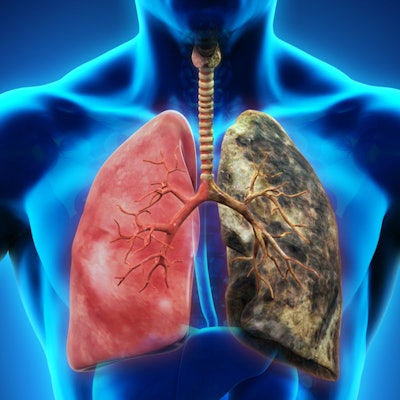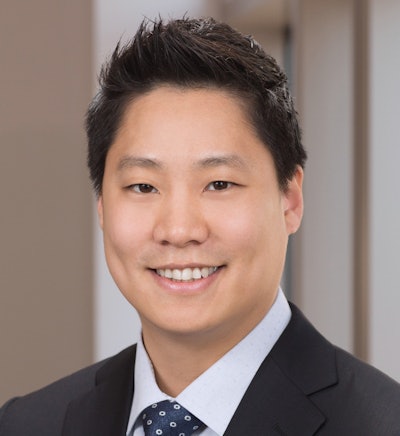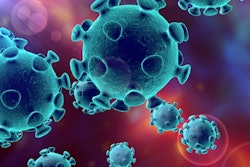
CT lung cancer screening programs that offer incentives for screening individuals with high mortality risk may not only boost participation rates but also could lead to considerable health and financial gains on a population level, according to an article published in the January issue of Health Affairs.
The researchers from Tufts University developed a simulation model to project changes to participation rates in CT lung screening when individuals received incentives to get screened. They subsequently used these projections to estimate the effect that screening individuals with a high risk of lung cancer mortality might have on the overall healthcare costs and mortality rate of National Lung Screening Trial (NLST) participants.
Their analysis revealed that individuals with the highest cancer mortality risk who underwent screening would gain more life-years and incur fewer healthcare costs than those with the lowest risk -- suggesting that using incentivized screening programs to target the highest-risk smokers could be the most effective way to improve screening outcomes (Health Aff, January 2019, Vol. 38:1, pp. 60-67).
"With the recent widespread integration of electronic health records, you can more easily identify individuals at high and low risk for lung cancer death," first author David Kim, PhD, told AuntMinnie.com. "But it doesn't stop there. After identifying the highest-risk individuals, we have the opportunity to provide financial incentives to increase uptake for CT lung screening. This will require a combined effort from physicians and insurance providers."
Targeting high-risk smokers
CT lung cancer screening has suffered from low participation among eligible smokers in the U.S., with rates dropping below 4% in 2015. The American Society of Clinical Oncology recently reported that the participation rate has only continued to dwindle, falling even further to 1.9% in 2016.
 David Kim, PhD, from Tufts University School of Medicine
David Kim, PhD, from Tufts University School of MedicineTo improve uptake for lung screening, various programs have considered a wide range of measures, from revising decision aids and bolstering patient outreach to offering providers financial incentives. Many groups have also proposed expanding the eligibility criteria to incorporate an individual's risk for lung cancer in light of research demonstrating that risk-prediction models may be able to increase the cost-effectiveness of screening and decrease cancer mortality.
"Prior knowledge has shown that there is a heterogeneous treatment effect for lung screening, meaning that some individuals get more benefits from screening than others," Kim said. "What if we could encourage higher-risk individuals who can benefit most from screening through an incentivized program?"
Attempting to answer that question, Kim and colleagues developed a health policy simulation model to project the outcome of a CT lung screening program that targeted smokers with the highest risk of cancer mortality. They applied their model to the NLST data and used multiple variables -- including age, sex, race, and smoking history -- to categorize the participants into five groups with varying cancer mortality risk.
The simulation model projected each NLST participant's accrued life-years and healthcare costs during the first seven years after initial screening. It then extrapolated the trial data to estimate potential net monetary benefit over the course of the individual's lifetime. The researchers defined net monetary benefit as the monetary value of life-years gained minus healthcare costs incurred from CT lung screening, compared with x-ray screening. They assigned a value of $100,000 for every life-year gained based on recommendations from current literature.
Incentivizing lung screening
In addition, the model estimated the potential health and cost benefits associated with offering incentives to providers and participants of screening. The model assumed that these incentives would increase participation rates to as much as 10% of eligible smokers -- more than double the reported rate of 3.9% in 2015.
They performed three separate simulations that assumed a different increase in participation rate for each of the five risk groups:
- A "conservative" simulation (for which 10% of the total increase in uptake occurred in the lowest-risk group and 30% in the highest-risk group)
- A "moderate" simulation (5% of the increase in the lowest-risk group; 35% in the highest-risk group)
- An "aggressive" simulation (no increase in the lowest-risk group; 50% increase in the highest-risk group)
After analyzing the results, the researchers found that CT lung screening led to greater life-year gains and net monetary benefit with increasing lung cancer mortality risk when compared with x-ray screening. The life-year gains for individuals categorized into the highest-risk group were 2.9 times greater than for those in the lowest risk group.
The seven-year projections also revealed that the net monetary benefit would increase in accordance with a greater emphasis on screening the highest-risk group. The "aggressive" scenario resulted in nearly two times the net monetary benefit of the "conservative" scenario.
When assuming that incentivizing programs would boost the participation rate to 10%, there was an even greater increase in total life-years gained and net monetary benefit for CT lung screening compared with x-ray screening.
| Benefits of risk-targeted CT lung cancer screening | ||||
| Per 100,000 eligible individuals | Nontargeted screening | Risk-targeted screening | ||
| Conservative | Moderate | Aggressive | ||
| 3.9% screening participation rate | ||||
| Life-years gained | 2,746 | 3,301 | 3,594 | 4,195 |
| Net monetary benefit | $32 million | $73 million | $95 million | $142 million |
| 10% screening participation rate | ||||
| Life-years gained | 7,129 | 8,464 | 9,216 | 10,757 |
| Net monetary benefit | $83 million | $187 million | $246 million | $366 million |
The increases in net monetary benefit were further compounded when extending this projection beyond the first seven years after baseline screening. With an assumed screening uptake of 10%, the lifetime analysis projected that risk-targeted incentive programs would add between 2,470 (conservative scenario) and 6,600 (aggressive scenario) life-years and between $210 million and $560 million in net monetary benefit on top of the benefits afforded by nontargeted screening.
Improving screening uptake
"The key takeaway for policymakers is that, if the cost of implementing an incentivized screening program is less than the estimated net monetary benefit, then it will be worth it economically," Kim said.
The policy simulation model showed that targeting high-risk individuals through incentivized screening could provide benefits for population health. In what ways might clinicians and policymakers incentivize CT lung screening? Kim offered several possible routes, including the following:
- Provider-level bonuses. CT lung screening relies on the efforts of primary care physicians, but their general lack of knowledge concerning reimbursement and clinical guidelines for screening has proved to be a major barrier to effective uptake, he said.
Research has shown that offering provider-level incentives for Pap smears based on the proportion of eligible patients who received the test was associated with higher cervical cancer screening rates, compared with the traditional fee-for-service model. In the case of lung cancer, payors could tie reimbursement to CT lung screening referral goals, especially for individuals with the highest risk of mortality.
- Financial incentives for patients. The patients themselves also need incentives, and screening programs could offer health plan premium subsidies or cash bonuses to eligible individuals.
- Additional initiatives. Combining screening with other initiatives such as smoking cessation and counseling could increase their collective value and improve system-wide efficiency.
"The most unique thing [about this study] is that even though the simulation model is hypothetical, the analysis allows us to offer practical approaches to improving uptake," Kim said. "It is my hope that these data can add to the continuing discussion about how to increase CT lung screening uptake."




















